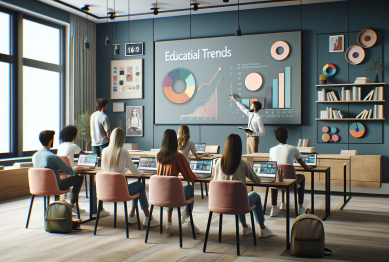Explore the impact of remote learning on modern education and how new digital classrooms might influence your academic journey. Uncover the benefits, challenges, and evolving teacher-student connection that shape the way millions now learn online.
How Online Classrooms Are Reshaping Learning
Classrooms once meant students gathered in the same room, but today the definition is broader. More people connect through virtual platforms than ever, and the digital classroom is accessible no matter where a learner lives. With high-speed internet and interactive platforms, education is no longer tied to physical space. Online learning management systems, live video tools, and discussion boards create a new ecosystem where collaboration feels dynamic and immediate. This digital shift brings flexibility for learners balancing jobs, family, or distance from traditional institutions.
Educators now record lessons, share resources instantly, and support large groups through forums or real-time messaging. Virtual learning platforms such as Coursera, Canvas, and Google Classroom have amplified teacher reach, enabling engagement far beyond the four walls of a school. This expansion introduces students to courses, peers, and instructors from around the globe, encouraging diverse perspectives within any digital classroom. The online academic environment has become essential, with millions accessing digital resources to advance their education at their own pace or according to their schedules.
Some students thrive in an online setting due to tailored pacing or accessibility features. Adaptive learning tools let users move forward once they have mastered material, rather than keeping everyone on a strictly fixed schedule. For those with special educational needs, digital technology can offer extra assistance or personalization that once seemed out of reach. By breaking down geographical and physical barriers, remote learning platforms continue to transform educational access and drive inclusivity for the broadest range of learners.
Key Benefits of Remote Learning for Students
One significant benefit is flexibility. Students can log in from anywhere—home, library, or even while traveling—expanding participation beyond the classroom. This flexibility helps accommodate those managing work schedules, caregiving, or health considerations, which might otherwise disrupt education. Remote learning also fosters self-paced study. Learners can review recorded lectures, pause content, or explore resources repeatedly until confident in the material. This approach helps students absorb complex concepts and supports different types of learners.
Access to digital learning resources is another major advantage. Online courses provide students with open courseware, video content, interactive quizzes, and instant feedback tools. These resources allow for a richer educational journey. Platforms like edX and MIT OpenCourseWare offer thousands of free courses in subjects ranging from engineering to art history. Such availability can help reduce education costs and opens pathways that were previously expensive or exclusive (Source: MIT OpenCourseWare).
Digital classrooms also support collaboration among students who might otherwise never meet. Online forums and group projects encourage global networking, often introducing learners to entirely new perspectives. This ongoing interaction helps build communication skills and will be invaluable for future professional environments. Asynchronous and synchronous engagement combined provides a well-rounded digital education, catering to a variety of schedules and learning styles, and empowering more people to pursue their academic or professional goals.
The Evolving Role of Teachers in Digital Education
Teachers have adapted to become facilitators in digital environments. Instead of being the only source of information, educators now guide students through curated online resources and activities. Video lectures, interactive assignments, and virtual office hours replace much of the traditional classroom routine, prompting instructors to master new digital tools for lesson delivery and student assessment. This evolution requires ongoing professional development for teachers, as technology in education continuously advances (Source: Edutopia).
Assessment standards have changed as well. With students learning remotely, quizzes and assignments need strong monitoring, but also innovative formats. Teachers use digital tools for instant grading, plagiarism detection, and personalized feedback. These advancements help educators spot learning gaps quickly and address individual needs. Online teaching requires creative strategies to keep students engaged—think gamification, real-time polls, or multimedia storytelling—which enriches the learning experience and builds engagement.
Digital education prompts stronger teacher-student connections in some ways. With chat functions, video calls, and one-on-one virtual meetings, students may feel more empowered to raise questions or share feedback compared to in-person classes. For educators, these private channels foster customized support that helps learners succeed. The evolving teacher role, balancing tech skills and human empathy, is at the heart of the new digital classroom landscape and central to remote learning success.
Challenges and Limitations of Remote Instruction
Despite many benefits, remote learning also presents real challenges. Internet access disparities can prevent some students from logging in consistently or completing assignments. Areas with limited broadband or unreliable connectivity face ongoing obstacles, sometimes referred to as the ‘digital divide.’ This gap particularly affects rural and underserved populations, limiting their access to quality education and highlighting ongoing issues of equity (Source: Pew Research Center).
Another challenge is engagement and motivation. Without the daily rhythm of in-person classes, some learners find it hard to maintain focus, stay on schedule, or feel connected to their peers and instructors. Digital fatigue can set in, causing reduced participation and increased feelings of isolation. Educators and platforms must find creative ways to encourage engagement, such as interactive exercises or group discussions, so student progress does not stagnate.
There are concerns about academic integrity in remote settings. Online testing and assignment submissions pose risks of plagiarism and reduced learning rigor, making robust honesty policies and monitoring important. Additionally, not all subjects translate easily to virtual formats—laboratory sciences, performing arts, and vocational training can lose essential hands-on components when taught entirely online. These challenges push educators and technology developers to seek innovative ways to enhance instruction while prioritizing academic fairness and comprehensive learning.
Inclusive Features and Accessibility in Digital Learning
Remote platforms have unlocked new opportunities for students with disabilities. Features such as screen readers, subtitles, adjustable fonts, and keyboard navigation help ensure content is accessible for everyone. Many courses now offer customizable pace settings or alternative media formats (audio, video, transcripts), making them more inclusive. This universal design benefits not only those with disabilities but anyone who prefers to learn in different ways (Source: CAST).
Institutions increasingly collaborate with advocacy groups and tech providers to improve accessibility. Continuous updates and testing drive progress toward compliance with international accessibility standards. Schools that invest in staff training and accessible interface design ultimately build a competitive edge—welcoming more diverse learners into their virtual classrooms and showcasing a commitment to education for all.
Despite this progress, barriers remain. Some platforms are not fully optimized for mobile learning or multilingual support, leaving gaps for students outside main demographics or language groups. Ongoing advocacy is essential for ensuring equal access. As more educators and developers understand the importance of truly inclusive design, digital education will better serve every learner, regardless of their circumstances or needs.
Your Future in a Connected Global Learning Community
The most exciting promise of remote learning is the chance to join an international community. Learners build global networks, exchange ideas across borders, and increase their cultural competence, which will be critical in tomorrow’s workplaces. International discussion boards, guest lectures, and global group projects let people see their own studies through different lenses, growing both academically and personally (Source: World Economic Forum).
As digital education expands, more people access advanced courses, professional certification pathways, or skill-based programs that were once hard to reach. This democratization of knowledge helps level the playing field for students around the world. Greater access to expert-led classes, innovative content, and contemporary skills development makes high-quality education a reality for millions more aspiring learners (Source: UNESCO).
The future of learning is interconnected, flexible, and increasingly personalized. With rapid advances in technology, new methods will emerge that make education even more adaptable to individual needs and interests. While the road will have bumps, remote learning is opening doors for more students, educators, and communities everywhere to participate meaningfully in a connected world.
References
1. MIT OpenCourseWare. (n.d.). About OCW. Retrieved from https://ocw.mit.edu/about
2. Edutopia. (n.d.). Distance Learning: Tips and Strategies. Retrieved from https://www.edutopia.org/distance-learning
3. Pew Research Center. (2021). Internet/Broadband Fact Sheet. Retrieved from https://www.pewresearch.org/internet/fact-sheet/internet-broadband/
4. CAST. (n.d.). About Universal Design for Learning. Retrieved from https://www.cast.org/impact/universal-design-for-learning-udl
5. World Economic Forum. (2020). Why digital learning is here to stay. Retrieved from https://www.weforum.org/agenda/2020/04/coronavirus-education-global-covid19-online-digital-learning/
6. UNESCO. (n.d.). Distance learning solutions. Retrieved from https://en.unesco.org/covid19/educationresponse/solutions









